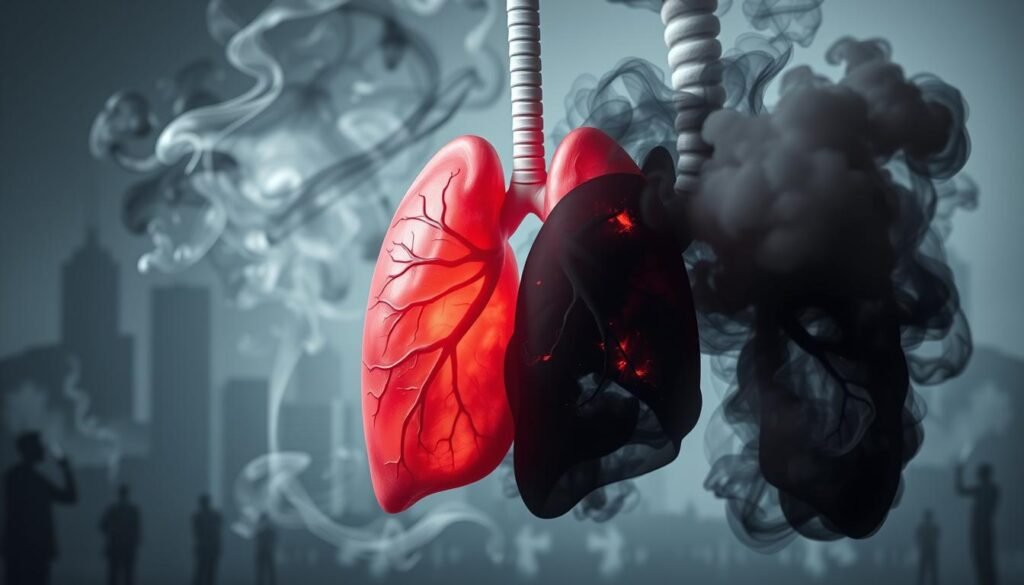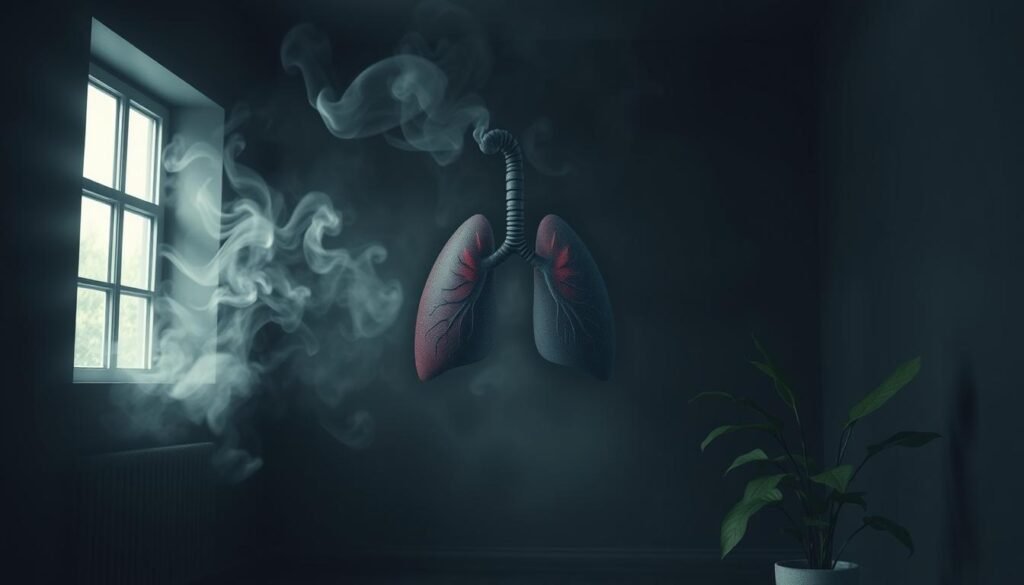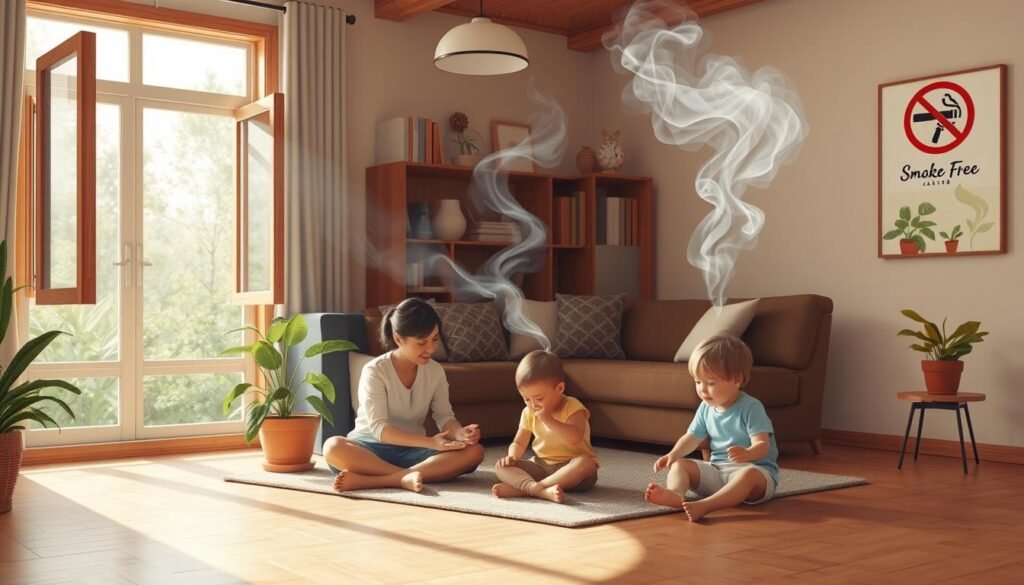More than 33,000 deaths from heart disease and over 7,000 deaths from lung cancer every year in the U.S. are linked to secondhand smoke. This fact shows the heavy impact of Environmental Tobacco Smoke on health. Secondhand smoke, or passive smoking, comes from smoke exhaled by smokers and from burning tobacco products. It’s important to know about secondhand smoke and its health effects. This helps in avoiding it in places like homes, work, and public areas.
Tobacco smoke contains over 7,000 chemicals, with 69 known to cause cancer. Others are harmful too. Even a short time exposed can cause health issues. That’s why it’s key to have smoke-free places. Laws and health policies are critical in shielding people, especially kids, from secondhand smoke. For deeper insight into its negative effects, check out this resource.
Key Takeaways
- Secondhand smoke leads to over 33,000 heart disease and 7,000 lung cancer deaths annually in the U.S.
- Exposure to secondhand smoke can increase heart disease risk by up to 30%.
- Children exposed to secondhand smoke face greater risks of respiratory issues and SIDS.
- Legislation banning smoking in public spaces reduces secondhand smoke exposure.
- Damaging effects of secondhand smoke can begin in as little as five minutes.
- Home and workplace environments are common sources of secondhand smoke exposure.
- Creating smoke-free environments is essential for public health and well-being.
Understanding Secondhand Smoke
Secondhand smoke comes from cigarettes and is known as environmental tobacco smoke. It has over 7,000 chemicals, which are bad for the health. Some of these chemicals, like arsenic and formaldehyde, can cause cancer and heart disease.
When people breathe in secondhand smoke without wanting to, it’s called involuntary smoking. This can happen at home, work, or in public places. Kids are especially at risk and can face problems like hearing issues, weak bones, and lung troubles. If their parents smoke, they might miss more school and even start smoking themselves.
Smoke lingers in the air for hours, exposing people to its dangers even after the cigarette is out. Harmful chemicals are also in marijuana smoke and e-cig vapor. Although U.S. laws have helped by banning smoking in many spots, secondhand smoke still causes over 19,000 deaths a year. We need more awareness and efforts to tackle this issue.
What is Secondhand Smoke?
Secondhand smoke means breathing in smoke from others’ tobacco use. It’s hazardous because of its chemical content and how you’re exposed.
Definition and Composition
It’s smoke you inhale when near someone smoking tobacco, like cigarettes or cigars. This smoke has over 4,000 harmful substances and around 70 that can cause cancer. It comes from the smoker’s exhaled smoke and the burning end of their tobacco.
Mainstream smoke is what the smoker breathes out. Sidestream smoke comes directly from the burning tobacco. Sidestream smoke is worse because it has more toxic chemicals.
Types of Secondhand Smoke
Mainstream and sidestream are the two kinds of secondhand smoke. Sidestream smoke is particularly bad due to its extra toxic chemicals. It has more nicotine, carbon monoxide, ammonia, and formaldehyde than mainstream smoke. This makes it extremely harmful to anyone who breathes it in.
Common Sources of Exposure
You’re exposed to secondhand smoke around smokers, in closed areas like homes or cars, and in public places like cafes or bars. Smoking indoors worsens indoor air pollution. This creates dangerous air for everyone, especially kids and pregnant women.
Secondhand smoke can cause many health problems. Those around it may get sick like smokers do. Children in smoking homes may have more lung problems, such as asthma. For details on smoking risks, visit this link.
Health Risks Associated with Secondhand Smoke
Secondhand smoke is harmful to everyone, adults and children alike. Knowing the dangers is key to better health and choices. Many studies show that being around secondhand smoke can cause serious health problems, leading to death and chronic illnesses.
Effects on Adults
Non-smoking adults who breathe in secondhand smoke face more health risks. Studies show that such exposure can lead to:
- Approximately 3,000 lung cancer deaths annually.
- Close to 34,000 deaths from heart disease each year.
- A heightened risk of stroke, which can rise by as much as 30%.
The dangers also include chronic issues like bronchitis, respiratory infections, and poor heart health. Secondhand smoke can linger, posing invisible threats even after the smoke clears.
Effects on Children
Children are very susceptible to the bad effects of secondhand smoke. The impacts of exposure include:
- Many ear infections, with about 790,000 children seeing doctors every year for this.
- A higher chance of respiratory problems, affecting up to 300,000 babies and toddlers annually.
- Worse asthma symptoms for affected kids, sometimes needing hospital care.
- An increased possibility of Sudden Infant Death Syndrome (SIDS), linked to about 430 U.S. deaths a year.
Children breathing in secondhand smoke may also face long-term health issues, like weak lungs and higher chances of lung cancer and heart disease. It’s crucial to keep kids’ spaces free from smoke to reduce these risks.
| Health Risks | Adults | Children |
|---|---|---|
| Lung Cancer Deaths | Approx. 3,000 annually | Increased risk later in life |
| Heart Disease Deaths | Approx. 34,000 annually | N/A |
| Increased Stroke Risk | 20% to 30% increase | Higher risk for developing cardiovascular issues |
| Respiratory Issues | Chronic bronchitis, infections | Asthma, ear infections, lung development problems |
| SIDS Risk | N/A | Approx. 430 deaths annually |
Secondhand Smoke and Lung Cancer
Secondhand smoke is really harmful, particularly with lung cancer. It causes more than 7,300 lung cancer deaths yearly in non-smokers in the U.S. This shows the big health issue secondhand smoke is.
Statistics on Lung Cancer Deaths
Studies show how risky secondhand smoke is. Being around secondhand smoke before turning 25 ups the lung cancer risk to 1.30. But this risk lowers to 0.66 if exposed after 25. It’s similar for those who’ve never smoked, with the risk being 1.29 before age 25 and 0.87 after.
Smokers and ex-smokers face a risk of 1.28 when exposed early. It shows early life is a crucial time for lung cancer risk due to secondhand smoke.
Youth are more at risk due to their lung development phase. Lungs grow a lot before 18, but can keep growing until 25. Workplace secondhand smoke is especially bad for non-small cell lung cancer. Even with efforts to reduce it, young people are still at high risk, partly due to certain marketing tactics.
Mechanisms of Cancer Development
Secondhand smoke has over 50 carcinogens, even more potent than direct smoke. This causes cell and DNA damage, which can lead to lung cancer. These changes start cancer processes, like what happens to smokers. The more you’re exposed, the higher the cancer risk.

For more on secondhand smoke and lung cancer risks, see this link. Understanding these risks is key to prevent exposure to tobacco smoke in the environment.
Cardiovascular Diseases Linked to Secondhand Smoke
Secondhand smoke seriously harms heart health. It’s linked to major issues like heart disease and stroke. Raising awareness and taking action is critical.
Coronary Heart Disease
Every year, coronary heart disease claims about 480,000 lives in the U.S. It’s a top killer.
Being around smoke, even if you don’t smoke, raises your heart disease risk. This fact comes from the 2001 Surgeon General’s report. It’s especially true for non-smokers.
Studies show a clear risk increase from secondhand smoke. The more you’re exposed, the higher your risk. Women are particularly vulnerable, needing focused health campaigns.
Stroke Risk
Secondhand smoke also ups your stroke risk by 20-30%. It hurts your blood vessels, making it hard for blood to flow. This can lead to strokes.
About 158,000 die from strokes each year in the U.S. Knowing about the smoking link is vital. This is especially true in public places and homes.
| Cardiovascular Disease | Annual Deaths in the US | Risk Increase from Secondhand Smoke |
|---|---|---|
| Coronary Heart Disease | 480,000 | Significant |
| Stroke | 158,000 | 20-30% |
Respiratory Problems Due to Secondhand Smoke
Being around secondhand smoke can cause big problems, especially for breathing. Both kids and adults can get chronic lung issues from it. Little kids who breathe in these bad stuff can get sick with infections in their lungs, like pneumonia and bronchitis.
People who already have asthma will feel worse around secondhand smoke. They may start coughing, wheezing, or have trouble breathing right away. Over time, this can lead to serious lung problems.
The numbers are shocking. Every year, because of secondhand smoke, up to 300,000 kids under 18 months old get bronchitis or pneumonia. Also, about 7,300 nonsmokers die from lung cancer annually. This shows how dangerous secondhand smoke is.
Children whose moms were around secondhand smoke while pregnant may also have lung problems later. This highlights why it’s crucial to avoid secondhand smoke in our homes and communities.

Sudden Infant Death Syndrome (SIDS) and Secondhand Smoke
Secondhand smoke is very dangerous to newborns. It’s closely linked to Sudden Infant Death Syndrome (SIDS). Newborns exposed to secondhand smoke have a higher risk of SIDS. This is because harmful chemicals from the smoke can affect their breathing.
Impact on Newborns
Infants around secondhand smoke face serious health issues. Studies show they can’t process nicotine well, making its effects worse. Infants who have passed away from SIDS had more nicotine in their lungs. This proves how bad secondhand smoke is. So, it’s crucial for parents and caregivers to keep their kids away from smoke.
Statistical Overview of SIDS Cases
The numbers concerning SIDS are alarming. Not smoking while pregnant could stop about one-third of SIDS deaths. Moreover, 70% of SIDS victims were often around a lot of smoke. A study also found a clear link between smoking and SIDS. This shows the importance of staying smoke-free for babies’ safety.
| Parameter | SIDS Cases | Non-SIDS Cases |
|---|---|---|
| Average Nicotine Concentration in Lung Tissue (ng/g) | 19.64 | 7.86 |
| Percentage of SIDS Victims Exposed to Secondhand Smoke | 70% | N/A |
| Estimated Reduction of SIDS Deaths with No Maternal Smoking | ~33% | N/A |
Preventive Measures Against Secondhand Smoke Exposure
It’s key to fight the risks of secondhand smoke through effective prevention. Creating smoke-free places and strong health policies helps. This way, communities can lower the health dangers tied to secondhand smoke.
Creating Smoke-Free Environments
Making areas smoke-free is essential in reducing secondhand smoke exposure. Implementing no-smoking rules at homes, work, and in public spaces protects people. It keeps them away from harmful substances found in smoke. Some key steps are:
- Banning smoking in homes, including e-cigarettes, protects kids and others at risk.
- Smoke-free zones in public spots like eateries, parks, and malls create safer spaces.
- No-smoking policies in buildings with many homes stop smoke from moving between units.
- Strict rules against smoking in cars with children help clear out toxins faster.
Legislation and Public Health Policies
Laws and health policies are crucial to curb secondhand smoke’s risks. Significant measures taken include:
- Many places in the U.S. have laws for smoke-free spaces to guard against secondhand smoke.
- The U.S. Department of Housing and Urban Development demands smoke-free rules in public housing. It shows a strong health commitment.
- Texas schools are tobacco-free. This encourages healthy living among students and teachers.
- There’s ongoing support for smoking cessation programs. They offer counseling and medicines to help people stop smoking.

The Role of Thirdhand Smoke in Health Risks
Thirdhand smoke leaves behind residues and contaminants from tobacco use. These toxic compounds end up on surfaces like walls and furniture. Even when smoke isn’t visible, these dangerous chemicals linger. They pose health risks, especially to kids and pets who touch these areas often.
Studies indicate thirdhand smoke includes over 250 harmful chemicals. These contribute to severe health issues. For example, kids exposed to it may suffer more from respiratory infections and ear problems. The American Academy of Pediatrics states avoiding tobacco smoke is key to protect kids.
Babies exposed to thirdhand smoke face serious danger. It can cause airway swelling and increase sudden death risk in babies (SUDI). Low-income families’ children have higher tobacco exposure, showing a health risk gap across socioeconomics.
Thirdhand smoke’s toxins can stick around for a long time. They might stay on surfaces for weeks or months. This puts new tenants at risk in previously contaminated living spaces. Knowing the dangers of thirdhand smoke is crucial for safety. Click here to learn more.
Not smoking and keeping living spaces smoke-free is the best way to avoid risks. These steps help protect everyone, not just smokers. This includes protecting babies and children from harm.
Conclusion
It’s important to know about the dangers of secondhand smoke. This knowledge helps us see how deeply it affects our health and communities. Research shows it greatly raises the risk of diseases like heart disease and lung cancer, especially for those around smoke often. Studies tell us that 34,000 people in the U.S. die each year from heart disease caused by secondhand smoke. This shows we need to spread awareness and take action.
Making places smoke-free and creating strict laws are key to lessen exposure. When places ban smoking, we see quick health benefits. For instance, there are fewer cases of heart attacks. By working together, we can make our communities healthier for everyone, whether they smoke or not.
Knowing about the dangers of secondhand and thirdhand smoke is crucial. To fight the health risks from tobacco, we must raise awareness and act. Doing so helps protect the health of future generations.